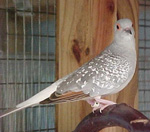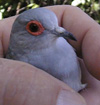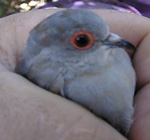Log in
PPO TIme
Top posters
| Dammam (1384) | ||||
| acruz (1049) | ||||
| zapco (915) | ||||
| dennis_go (910) | ||||
| .bygafricans. (854) | ||||
| mhyke7 (787) | ||||
| kingphilipkennel (528) | ||||
| lutinoman (519) | ||||
| blessmar (419) | ||||
| lestre (236) |
Latest topics
Search
DIAMOND DOVES (Geopelia Cuneate)
Page 1 of 1
 DIAMOND DOVES (Geopelia Cuneate)
DIAMOND DOVES (Geopelia Cuneate)
Diamond Dove are about the size of a sparrow only with a longer tail, they are seedeaters and prolific breeders.
Breeding this dove in captivity is easy by keeping each mated pair separately to avoid fighting among the males and several hens laying in the same nest. A cage 2 feet square is suitable for one pair of doves. However, several pairs housed together will readily raise young in a spacious pen with shelters to serve as roosting and hiding places. Ample space should be provided so that the pairs need not encroach on their neighbors' breeding territories. They will readily nest in small, open-top boxes or baskets place high off the ground in secluded corners of the cage or pen. They lay two creamy white eggs, which male & female incubate alternately from 11 to 15 days. The babies grow very fast, leaving their nest at the age of about 10 days. They may be left with their parents as long as the latter will tolerate them, and as long as they do not interfere with subsequent nestings. The young mature quickly and are capable of breeding in about 4-5 months. The sexes can be distinguished at about 6-8 weeks of age.

Feeding Diamond Doves is simple. We give our doves standard finch mix. When available we also add wild bird seed without sunflowers seeds. They also get small bird grit or finely crushed eggshell. Moisten game bird starter or poultry layer crumbles is also offered when breeding. We also add clean sand in the bottom of their pen for them to rummage through, they like that. They like a bath and we use a plastic flower pot bottom for this.
Diamond Doves should be kept reasonably warm. They can tolerate frost and freezes for short periods only. If your winters are long and hard we recommend a heat light or better yet bring them inside.
Breeding this dove in captivity is easy by keeping each mated pair separately to avoid fighting among the males and several hens laying in the same nest. A cage 2 feet square is suitable for one pair of doves. However, several pairs housed together will readily raise young in a spacious pen with shelters to serve as roosting and hiding places. Ample space should be provided so that the pairs need not encroach on their neighbors' breeding territories. They will readily nest in small, open-top boxes or baskets place high off the ground in secluded corners of the cage or pen. They lay two creamy white eggs, which male & female incubate alternately from 11 to 15 days. The babies grow very fast, leaving their nest at the age of about 10 days. They may be left with their parents as long as the latter will tolerate them, and as long as they do not interfere with subsequent nestings. The young mature quickly and are capable of breeding in about 4-5 months. The sexes can be distinguished at about 6-8 weeks of age.

Feeding Diamond Doves is simple. We give our doves standard finch mix. When available we also add wild bird seed without sunflowers seeds. They also get small bird grit or finely crushed eggshell. Moisten game bird starter or poultry layer crumbles is also offered when breeding. We also add clean sand in the bottom of their pen for them to rummage through, they like that. They like a bath and we use a plastic flower pot bottom for this.
Diamond Doves should be kept reasonably warm. They can tolerate frost and freezes for short periods only. If your winters are long and hard we recommend a heat light or better yet bring them inside.

Dammam- Global Moderator

 SEXING DIAMOND DOVES
SEXING DIAMOND DOVES
Sexing Diamond Doves consists of simple observations and comparisons of the "eye ceres". This is the bare skin surrounding the eye of the bird. There are exceptions to these "rules". Conditions, feed, surroundings, etc can all be factors in the growth and physical appearance of the bird and thus may not follow these observations.
Trying to determine the sex of the birds is best when they have attained at least 6 months of age or have gone through the juvenile to pre-adult plumage molt. Between 6 and 12 months of age is when the male’s cere begins to enlarge. Remember outside factors, as stated above, may affect this cere development
Most mature adult male Diamond Doves will have larger, fleshier looking and many times a brighter colored eye cere then the adult female Diamond. Females with large brightly colored ceres do occur, as do males with small dull colored ceres. The coloration of the eye cere cannot always be accurate for sexing males from females. The cere coloration can vary greatly from one bird to the next regardless of sex. These facets can be due to breeding linage or even outside factors as stated above. A male DD kept indoors, with full spectrum lighting and everything else the bird needs when kept indoors, for a year will have a different looking eye cere then a male kept in an outdoor flight with access to the direct sunlight etc., whether they be from the same parents or not. Older male and female Diamonds do sometimes grow quite enlarged eye ceres. These enlarged ceres can become infected.
DIAMOND DOVE
EYE CERE COMPARISONS
The pictures on this page show the typical differences of the eye cere in male and female Diamond Doves. These pictures are presented as an aid factors, such as being kept indoors, can affect what the cere may look like.

MALE

FEMALE
The above two birds are BLUE White Rumped Diamonds. Both birds are 8 months old. Note the "thickening" of the male's eye cere.
Trying to determine the sex of the birds is best when they have attained at least 6 months of age or have gone through the juvenile to pre-adult plumage molt. Between 6 and 12 months of age is when the male’s cere begins to enlarge. Remember outside factors, as stated above, may affect this cere development
Most mature adult male Diamond Doves will have larger, fleshier looking and many times a brighter colored eye cere then the adult female Diamond. Females with large brightly colored ceres do occur, as do males with small dull colored ceres. The coloration of the eye cere cannot always be accurate for sexing males from females. The cere coloration can vary greatly from one bird to the next regardless of sex. These facets can be due to breeding linage or even outside factors as stated above. A male DD kept indoors, with full spectrum lighting and everything else the bird needs when kept indoors, for a year will have a different looking eye cere then a male kept in an outdoor flight with access to the direct sunlight etc., whether they be from the same parents or not. Older male and female Diamonds do sometimes grow quite enlarged eye ceres. These enlarged ceres can become infected.
DIAMOND DOVE
EYE CERE COMPARISONS
The pictures on this page show the typical differences of the eye cere in male and female Diamond Doves. These pictures are presented as an aid factors, such as being kept indoors, can affect what the cere may look like.

MALE

FEMALE
The above two birds are BLUE White Rumped Diamonds. Both birds are 8 months old. Note the "thickening" of the male's eye cere.

Dammam- Global Moderator

 THE FLIGHT CAGE
THE FLIGHT CAGE
The "flight cage" or "aviary" can be of any size which suits your tastes and available space. One thing I have learned, build the flights to your needs to facilitate cleaning or any other chore you may need to do within the confines of the flight. The birds will adapt to what you supply them to live in.
I often tell fanciers who build outdoor flights to cover the tops of the flights. This keeps wild birds from perching on the open tops and leaving their dropping inside your flights & thus exposing your birds to many diseases the wild birds may carry. Also, doves have a "predator instinct" in which they fly straight upwards with great force. If the tops are not covered the "wire" may become invisible when the birds take "flight" in this instinctual behavior. The birds can be severely injured and death can also occur from broken necks in these headlong flights.
All my outdoor flights are made from treated lumber and covered with ½" hardware cloth wire. This size keeps a great many varmints out of the flights. If I build any more flights I will utilize the ¼" hardware cloth wire instead of the ½" size. Mice and small snakes can go through the ½" wire.
Utilize many different sizes for the perches within the flight. Make sure the perches are firmly secured and that none are directly over any feed or water containers. Perches can be wood dowels, thick ropes (doves do not utilize the rope perches much but any finches in the flight will), branches, ripped lumber of varying sizes. Even homemade wooden platforms can be used. Rough perches are much better then smooth or slick perches.
If several pairs of birds are to be housed in the flight it is a good idea to supply a couple of feed and water containers, with each being in a different location. This cuts down on the chances of a dominant bird or pair from keeping other pairs or young from obtaining feed and water.
I often tell fanciers who build outdoor flights to cover the tops of the flights. This keeps wild birds from perching on the open tops and leaving their dropping inside your flights & thus exposing your birds to many diseases the wild birds may carry. Also, doves have a "predator instinct" in which they fly straight upwards with great force. If the tops are not covered the "wire" may become invisible when the birds take "flight" in this instinctual behavior. The birds can be severely injured and death can also occur from broken necks in these headlong flights.
All my outdoor flights are made from treated lumber and covered with ½" hardware cloth wire. This size keeps a great many varmints out of the flights. If I build any more flights I will utilize the ¼" hardware cloth wire instead of the ½" size. Mice and small snakes can go through the ½" wire.
Utilize many different sizes for the perches within the flight. Make sure the perches are firmly secured and that none are directly over any feed or water containers. Perches can be wood dowels, thick ropes (doves do not utilize the rope perches much but any finches in the flight will), branches, ripped lumber of varying sizes. Even homemade wooden platforms can be used. Rough perches are much better then smooth or slick perches.
If several pairs of birds are to be housed in the flight it is a good idea to supply a couple of feed and water containers, with each being in a different location. This cuts down on the chances of a dominant bird or pair from keeping other pairs or young from obtaining feed and water.

Dammam- Global Moderator

 NESTING
NESTING
Supplying the Diamond Doves with nesting materials is simple; many items can be used. Soft dried grasses, hay, straw, soft pine needles (white pine needles are ideal for the Diamonds), small pliable twigs etc., can be given in sizable amounts where all the nesting pairs can select what they feel is needed. Not all birds will make the ideal nest, some will use too much material and others will only use a few pieces.
I utilize the Flight Breeding system on several of my Diamond Dove pairs. I feel the flight situation is beneficial to them. They have flight room to exercise. I like to see several pair interacting as they might do in the wild. It is a wonderful sight to see a pair raising their family or sunning themselves in the sunlight. One thing I do advocate is the removal of the young Diamonds when they are on their own. If left in the flight they soon mature and can cause interference with the established pairs.
I promote this system for those fanciers who are not concerned with developing a color mutation or needing to keep accurate records on the birds. I have listed my pros & cons of this system below.
PROS: plenty of flight room for strong bird; less cleaning time for the fancier; watching the interactions of a Diamond pair and their offspring; watch the beautiful courtship displays of the males; many times the young males can be sexed before they finish the "ten week" molt. The young males tend to show or try their breeding prowess with other young or their parents.
CONS: there is no control over which male breeds which hen. Yes, females will allow another male to breed them in this type of breeding system. Many times the bonded pair male will not allow this male to share incubation or rearing of the chicks, but the hen may accept this different male’s advances while she is off the nest duties. If a new color mutation appears there is no way to accurately say which birds are responsible. Multiple eggs are laid in the same nest, thus causing the different pairs to fight over the right to set the eggs. Eggs or young can be knocked from the nest in such fighting. The possibility of two eggs remaining in such chosen sites and hatching is compromised. Eggs can be abandoned after a pair is chased from the chosen nest site. Hatchlings can be trampled by adult birds squabbling over the nest.
In closing this article, adapt the basics found here to your personal situation in your quest to propagate these beautiful doves. Part two of the article discusses the Individual Cage Breeding experiences with Diamond Doves.
I utilize the Flight Breeding system on several of my Diamond Dove pairs. I feel the flight situation is beneficial to them. They have flight room to exercise. I like to see several pair interacting as they might do in the wild. It is a wonderful sight to see a pair raising their family or sunning themselves in the sunlight. One thing I do advocate is the removal of the young Diamonds when they are on their own. If left in the flight they soon mature and can cause interference with the established pairs.
I promote this system for those fanciers who are not concerned with developing a color mutation or needing to keep accurate records on the birds. I have listed my pros & cons of this system below.
PROS: plenty of flight room for strong bird; less cleaning time for the fancier; watching the interactions of a Diamond pair and their offspring; watch the beautiful courtship displays of the males; many times the young males can be sexed before they finish the "ten week" molt. The young males tend to show or try their breeding prowess with other young or their parents.
CONS: there is no control over which male breeds which hen. Yes, females will allow another male to breed them in this type of breeding system. Many times the bonded pair male will not allow this male to share incubation or rearing of the chicks, but the hen may accept this different male’s advances while she is off the nest duties. If a new color mutation appears there is no way to accurately say which birds are responsible. Multiple eggs are laid in the same nest, thus causing the different pairs to fight over the right to set the eggs. Eggs or young can be knocked from the nest in such fighting. The possibility of two eggs remaining in such chosen sites and hatching is compromised. Eggs can be abandoned after a pair is chased from the chosen nest site. Hatchlings can be trampled by adult birds squabbling over the nest.
In closing this article, adapt the basics found here to your personal situation in your quest to propagate these beautiful doves. Part two of the article discusses the Individual Cage Breeding experiences with Diamond Doves.

Dammam- Global Moderator

Page 1 of 1
Permissions in this forum:
You cannot reply to topics in this forum|
|
|








» Dynamically move your LCD on wall like this
» WHO MUST WE BLAME?
» LETS COUNT IN ENGLISH WORDS
» ENJOY THE COFFEE
» what should i do for my wall mount fireplace lcd
» what should i prepare for my home?
» INTERVIEW THE NEXT PERSON
» Want your feedback about fireplace LCD
» PARES PARES
» Mag sign in tayo dito
» Best Borwser